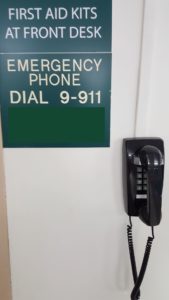Federal regulations of the U.S. Environmental Protection Agency (USEPA) at 40 CFR 262.17(a)(6) require a large quantity generator of hazardous waste (LQG) to comply with the preparedness, prevention, and emergency procedure standards of 40 CFR 262, subpart M. This article is the fourth in a series that looks closely at each of the sections in subpart M to clearly describe the responsibilities of a LQG.
The purpose of this article is to address the requirements of 40 CFR 262.253 Testing and maintenance of equipment.
Before we begin…
These regulations were revised by the Generator Improvements Rule. If your state has not yet adopted the new rule you must continue to comply with the earlier version until it does. You may read an article explaining the earlier version of the regulations (prior to implementation of the Generator Improvements Rule) here.
|
Not sure of your hazardous waste generator status? |
Scope and Applicability:
These regulations are applicable to a LQG. The requirements of a small quantity generator of hazardous waste (SQG) are almost exactly the same. If you are a SQG please refer to this article for your version of these regulations: Emergency Preparedness and Prevention for Small Quantity Generator: Testing and Maintenance of Equipment. (This article is not yet written. Please be patient.)
As made clear by §262.250 (revised by the Generator Improvements Rule), the preparedness, prevention, and emergency procedures of Subpart M are applicable to those areas of a LQG where hazardous waste is generated or accumulated. This includes:
- Central Accumulation Area (CAA)
- Satellite Accumulation Area (SAA)
Read: Applicability of Preparedness, Prevention, and Emergency Procedures for LQG
40 CFR 262.253 reads:
All communications or alarm systems, fire protection equipment, spill control equipment, and decontamination equipment, where required, must be tested and maintained as necessary to assure its proper operation in time of emergency.
Why the change?
No change at all other than the removal of the word “facility” from the opening sentence. Clearly, this section of the preparedness, prevention, and emergency procedures regulations did not require much improvement.
|
Interested in a Webinar that covers this topic, and more! |
Testing and maintenance of equipment:
Let’s take a closer look at the wording, terms, and phrases used in this section:
“All communications or alarm systems,…” The items listed here are the same as those identified as “required equipment” in an earlier section: §262.252 Required equipment. They are:
- Communications or alarm systems (both internal and external).
- Fire protection equipment (including special extinguishing equipment).
- Spill control equipment.
- Decontamination equipment
“…where required…” To determine where this equipment is required, refer to the the article I wrote on the first section of this subpart: 40 CFR 262.250 Applicability of Preparedness, Prevention, and Emergency Procedures. To summarize: “where required” is any location at a LQG where hazardous waste is generated or accumulated.
|
Contact me with any questions you may have about the generation, identification, management, and disposal of hazardous waste Daniels Training Services, Inc. 815.821.1550 |
“…must be tested and maintained…” This section requires the testing and maintenance of the required equipment. Note the following:
- The type and frequency of testing and maintenance is intentionally not defined by the USEPA, “…tested and maintained as necessary…”. This is due to the variety of systems and equipment encompassed by these regulations (communication, alarm, fire, spill control, etc.). It is up to the LQG to determine compliance based on guidance from the equipment manufacturer, industry standards, insurance provider, Fire Marshall, and if applicable, OSHA standards.
- Though the regulations do not require the maintenance of a record for a specified period of time to demonstrate compliance as it does for other RCRA Regulations (Read: Recordkeeping Requirements of RCRA), it is a good idea to maintain some form of a record and make it available upon inspection if necessary.
- A frequent occurrence in industry is the slow erosion of spill control and decontamination equipment reserved for emergencies as it is consumed for routine spills and housekeeping. Communicate and enforce policies to ensure emergency equipment is only used in emergencies. Other resources should be made available to employees to provide equipment for non-emergency clean-ups. In addition, routine inspections (perhaps weekly with your inspection of hazardous waste accumulation areas) is a good way to ensure necessary emergency equipment is available.
Is that it?
No. First of all, as a LQG you must still comply with the remaining requirements of §262, subpart M as revised by the Generator Improvements Rule.
And then, what about training? At §262.17(b)(7) – directly following the referral to emergency procedures – are the training requirements for a LQG. §262.17(b)(7)(i)(C) reads in part:
At a minimum, the training program must be designed to ensure that facility personnel are able to respond effectively to emergencies…
So clearly, Hazardous Waste Personnel Training at a LQG is important.

